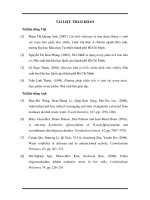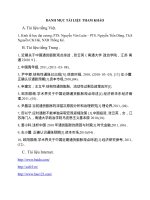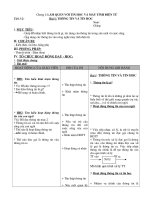Danh mục tài liệu tham khảo
Bạn đang xem bản rút gọn của tài liệu. Xem và tải ngay bản đầy đủ của tài liệu tại đây (116.59 KB, 15 trang )
TÀI LIỆU THAM KHẢO
Tài liệu tiếng Việt
[1] Phạm Thị Quang Anh, (2007), Cải biến chitosan và ứng dụng kháng vi sinh
vật trong bảo quản thực phẩm, Luận văn thạc sĩ chuyên ngành Hóa sinh,
trường Đại học Khoa học Tự nhiên thành phố Hồ Chí Minh.
[2] Nguyễn Thị Kim Phụng, (2005), Phổ NMR sử dụng trong phân tích hóa hữu
cơ, Nhà xuất bản Đại học Quốc gia thành phố Hồ Chí Minh.
[3] Lê Ngọc Thạch, (2002), Hóa học hữu cơ (Các nhóm định chức chính), Nhà
xuất bản Đại học Quốc gia thành phố Hồ Chí Minh.
[4] Trần Linh Thước, (1999), Phương pháp phân tích vi sinh vật trong nước,
thực phẩm và mỹ phẩm, Nhà xuất bản giáo dục.
Tài liệu tiếng Anh
[5] Biao-Shi Wang, Bian-Sheng Li, Qing-Xiao Zeng, Hui-Xia Liu, (2008),
Antioxidant and free radical scavenging activities of pigments extracted from
molasses alcohol waste water, Food Chemistry, 107, pp. 1198–1204.
[6] Boris Vauzeilles, Bruno Dausse, Sara Palmier and Jean-Marie Beau, (2001),
A one-step β-selective glycosylation of N-acetylglucosamine and
recombinant chitooligosaccharides, Tetrahedron Letters, 42, pp. 7567–7570.
[7] Caiqin Qin, Huirong Li, Qi Xiao, Yi Liu, Juncheng Zhu, Yumin Du, (2006),
Water solubility of chitosan and its antimicrobial activity, Carbohydrate
Polymers, 63, pp. 367–374.
[8] Dai-Nghiep Ngo, Moon-Moo Kim, Se-Kwon Kim, (2008), Chitin
oligosaccharides inhibit oxidative stress in live cells, Carbohydrate
Polymers, 74, pp. 228–234.
[9] Dai-Nghiep Ngo, Moon-Moo Kim, Won-Kyo Jung, Sang-Hoon Lee, Tae-Kil
Eom, Se-Kwon Kim, (2008), Antioxidant effect of novel
chitooligosaccharides derivatives, Journal of Biotechnology, 136S, pp. S527–
S540.
[10] Dai-Nghiep Ngo, Zhong-Ji Qian, Jae-Young Je, Moon-Moo Kim, Se-Kwon
Kim, (2008), Aminoethyl chitooligosaccharides inhibit the activity of
angiotensin converting enzyme, Process Biochemistry, 43, pp. 119–123.
[11] Donald L. Pavia, Gary M. Lampman, George S. Kriz, Introduction to
spectroscopy – Aguide for students of organic chemistry, Harcourt Brace
College Publishers.
[12] Dong-Xia Lee, Wen-Shui Xia, Jia-Li Zhang, (2008), Enzymatic preparation
of chitooligosaccharides by commercial lipase, Food Chemistry, 111, pp.
291–295.
[13] Douglasde Britto, Odılio B.G. Assis, (2007), A novel method for obtaining a
quaternary salt of chitosan, Carbohydrate Polymers, 69, pp. 305–310.
[14] E.V. Svirshchevskaya, L.G. Alekseeva, P.D. Reshetov, N.N. Phomicheva,
(2009), Mucoadjuvant properties of lipo- and glycoconjugated derivatives of
oligochitosans, European Journal of Medicinal Chemistry, 44, pp. 2030–
2037.
[15] Enzo Castagnino, M. Francesca Ottaviani, Michela Cangiotti, Mila Morelli,
Luca Casettari, Riccardo A.A. Muzzarelli, (2008), Radical scavenging
activity of 5-methylpyrrolidinone chitosan and dibutyryl chitin,
Carbohydrate Polymers, 74, pp. 640–647.
[16] Eric Samain, Sophie Drouillard, Alain Heyraud, Hugues Driguez, Roberto
A. Geremia, (1997), Gram-scale synthesis of recombinant
chitooligosaccharides in Escherichia coli, Carbohydrate Research, 302,
pp. 35-42.
[17] Eric Samain, Valerie Chazalet, Roberto A. Geremia, (1999), Production of
O-acetylated and sulfated chitooligosaccharides by recombinant Escherichia
coli strains harboring different combinations of nod genes, Journal of
Biotechnology, 72, pp. 33–47.
[18] Evgeniya A. Stepnova, Vladimir E. Tikhonov, Tatiana A. Babushkin, Tamara
P. Klimova, Evgeniy V. Vorontsov, Valery G. Babak, Sergey A. Lopatin,
Igor A. Yamskov, (2007), New approach to the quaternization of chitosan
and its amphiphilic derivatives, European Polymer Journal, 43, pp. 2414–
2421.
[19] F. Seyfarth, S. Schliemann, P. Elsner, U.-C. Hipler, (2008), Antifungal effect
of high- and low–molecular–weight chitosan hydrochloride, carboxymethyl
chitosan, chitosan oligosaccharide and N-acetyl-D-glucosamine against
Candida albicans, Candida krusei and Candida glabrata, International
Journal of Pharmaceutics, 353, pp. 139–148.
[20] Farooqahamed S. Kittur, Acharya B. Vishu Kumar, Mandyam C. Varadaraj
and Rudrapatnam N. Tharanathan, (2005), Chitooligosaccharides—
preparation with the aid of pectinase isozyme from Aspergillus niger and
their antibacterial activity, Carbohydrate Research, 340, pp. 1239–1245.
[21] Fereidoon Shahidi, Janak Kamil Vidana Arachchi and You-Jin Jeon, (1999),
Food applications of chitin and chitosans, Food Science & Technology, 10,
pp. 37-51.
[22] Fernanda Sousa , Georg M. Guebitz ,Vanja Kokol, (2009), Antimicrobial and
antioxidant properties of chitosan enzymatically functionalized with
flavonoids, Process Biochemistry, 44, pp. 749–756.
[23] Guiqian Lu, Dingcai Wu, Ruowen Fu, (2007), Studies on the synthesis and
antibacterial activities of polymeric quaternary ammonium salts from
dimethylaminoethyl methacrylate, Reactive & Functional Polymers, 67, pp.
355–366.
[24] Hisao Tomida, Takeshi Fujii, Nobuko Furutani, Akihiro Michihara, Taira
Yasufuku, (2009), Antioxidant properties of some different molecular weight
chitosans, Carbohydrate Research.
[25] Huang Ronghua, Du Yumin, Yang Jianhong, (2003), Preparation and
anticoagulant activity of carboxybutyrylated hydroxyethyl chitosan sulfates,
Carbohydrate Polymers, 51, pp. 431–438.
[26] Hui Ai, Furong Wang, Qiusheng Yang, Fen Zhu, Chaoliang Lei, (2008),
Preparation and biological activities of chitosan from the larvae of housefly,
Musca domestica, CarbohydratePolymers, 72, pp. 419–423.
[27] In-Yong Kim, Seog-Jin Seo, Hyun-Seuk Moon, Mi-Kyong Yoo, In-Young
Park, Bom-Chol Kim, Chong-Su Cho, (2008), Chitosan and its derivatives
for tissue engineering applications, Biotechnology Advances, 26, pp. 1–21.
[28] Jae-Young Je and Se-Kwon Kim, (2005), Water-soluble chitosan derivatives
as a BACE1 inhibitor, Bioorganic & Medicinal Chemistry, 13, pp. 6551–
6555.
[29] Jae-Young Je and Se-Kwon Kim, (2006), Reactive oxygen species
scavenging activity of aminoderivatized chitosan with different degree of
deacetylation, Bioorganic & Medicinal Chemistry, 14, pp. 5989–5994.
[30] Jae-Young Je, Eun-Kyung Kim, Chang-Bum Ahn, Sang-Ho Moon, Byong –
TaeJeon, Bo Kyung Kim, Tae-Kyu Park, Pyo-Jam Park, (2007), Sulfated
chitooligosaccharides as prolyl endopeptidase inhibitor, International
Journal of Biological Macromolecules, 41, pp. 529–533.
[31] Jae-Young Je, Young-Sook Cho and Se-Kwon Kim, (2006), Cytotoxic
activities of water-soluble chitosan derivatives with different degree of
deacetylation, Bioorganic & Medicinal Chemistry Letters, 16, pp. 2122–
2126.
[32] Juan Carlos Cabrera, Pierre Van Cutsem, (2005), Preparation of
chitooligosaccharides with degree of polymerization higher than 6 by acid or
enzymatic degradation of chitosan, Biochemical Engineering Journal, 25, pp.
165–172.
[33] Jukka olappa, artha jalmarsdottir, MarMasson, Ogmundur Runarsson, (2006),
Antimicrobial activity of chitosan N-betainates, Carbohydrate Polymers, 65,
pp. 114–118.
[34] Jung Hae Yoon, (2005), Enzymatic synthesis of chitooligosaccharides in
organic cosolvents, Enzyme and Microbial Technology, 37, pp. 663–668.
[35] K.V. Harish Prashanth and R.N. Tharanathan, (2007), Chitin/chitosan:
modifications and their unlimited application potential - an overview, Food
Science & Technology, 18, pp. 117-131.
[36] Kunio Esumi, Naoko Takei, Tomokazu Yoshimura, (2003), Antioxidant-
potentiality of gold–chitosan nanocomposites, Colloids and Surfaces B:
Biointerfaces, 32, pp. 117-123.
[37] Kyung W. Kim , R.L. Thomas, (2007), Antioxidative activity of chitosans
with varying molecular weights, Food Chemistry, 101, pp. 308–313.
[38] Lakia M. Champagne, (2008), The synthesis of water soluble N-acyl chitosan
derivatives for characterization as antibacterial agents, Louisiana State
University and Agricultural & Mechanical College.
[39] Lin Wang, Bishu Pan, Jianchun Sheng, Juan Xu, Qiuhui Hu, (2007),
Antioxidant activity of Spirulina platensis extracts by super critical carbon
dioxide extraction, Food Chemistry, 105, pp. 36–41.
[40] M. Marini, M. Bondi, R. Iseppi, M. Toselli, F. Pilati, (2007), Preparation and
antibacterial activity of hybrid materials containing quaternary ammonium
salts via sol–gel process, European Polymer Journal, 43, pp. 3621–3628.
[41] M. Thanou, B.I. Florea, M.Geldof, H.E. Junginger, G. Borchard, (2002),
Quaternized chitosan oligomers as novel gene delivery vectors in epithelial
cell lines, Biomaterials, 23, pp. 153–159.
[42] Maher Z. Elsabeea, Rania Elsayed Morsi, A.M. Al-Sabagh, (2009), Surface
active properties of chitosan and its derivatives, Colloids and Surfaces B:
Biointerfaces, 74, pp. 1–16.
[43] Ming-Tsung Yen, Joan-Hwa Yang, Jeng-Leun Mau, (2008), Antioxidant
properties of chitosan from crab shells, Carbohydrate Polymers, 74, pp. 840–
844.
[44] Mohamed E.I. Badawy, (2005), Fungicidal and insecticidal activity of O-
Acyl chitosan derivatives, Polymer Bulleti, 54, pp. 279–289.
[45] Moni Rani Saha, Md. Ashraful Alam, Raushanara Akter and Rumana
Jahangir, (2008), In vitro free radical scavenging activity of Ixora coccinea
L, Bangladesh J Pharmacol, 3, pp. 90-96.
[46] Mrunal R. Thatte, (2004), Synthesis and antibacterial assessment of water-
soluble hydrophobic chitosan derivatives bearing quaternary ammonium
functionality, Louisiana State University and Agricultural & Mechanical
College.
[47] N.M. Alves, J.F. Mano, (2008), Chitosan derivatives obtained by chemical
modifications for biomedical and environmental applications, International
Journal of Biological Macromolecules, 43, pp. 401–414.









